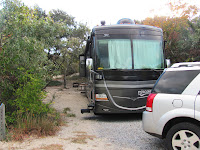
We drove a little over 200 miles south and settled in at First Landing State Park (
http://www.dcr.virginia.gov/state_parks/fir.shtml). Located on Cape Henry in Virginia Beach, VA, the park's name was changed in 1997 from Seashore State Park to First Landing to reflect its heritage of being the first place where the Englis

h colonists landed in 1607 who established Jamestown as the first permanent English settlement. Our site was directly across from the walkway that led to the beach situated along the Chesapeake Bay where cargo ships could be seen in the distance. Though cold and windy while we were there, it didn’t stop us from taking the dogs for a walk on the beach and even letting them off leash. You can see how much Abby enjoyed that as she bounds behind me!


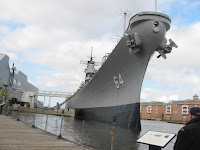
Since we planned to stay for a couple days, we decided to drive the short distance into downtown Norfolk one day and check out the Hampton Roads Naval Museum (
http://www.hrnm.navy.mil/) where the
USS Wisconsin is berthed, one of the largest and last battleships ever built by the Navy. The museum “celebrates the 234 years of history of the fleet in the Hampton Ro

ads region of Virginia” and was free according to what we had read. The battleship has been securely chained to the bottom of the Elizabeth River since Dec. 7, 2000 (57 years after it was first launched) and floats 2’-4’ above the bottom.
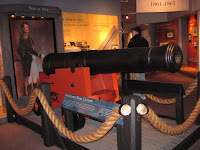
As it turns out, you can tour the museum for free, but at the beginning of the year the Navy turned the
USS Wisconsin over to the city who now charges to board and tour it (though admission also includes the interactive science and technology center). We were really disappoint

ed by this but chose to skip touring the battleship and simply partake of the museum’s free tour. What a fascinating place! The museum introduces you to over 200 years of naval activity in the area starting with the critical
Battle of the Capes in 1781. We had no idea the extent to which ships played a part in our nation’s history. There’s quite an impressive collection of ship models as well as artifacts pulled from the waters inc
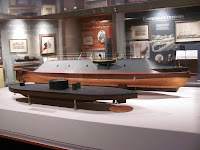
luding this 1,800 lb. anchor dating back to the 1800’s that was found in the river in 1993. An extensive number of exhibits help tell the story of naval operations through America’s history up to and including today’s Navy.
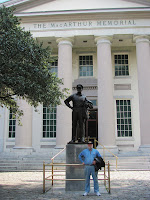
As we were leaving, we discovered that just a few blocks away was the Gen. Douglas MacArthur Memorial (
http://www.macarthurmemorial.org/), and it too was free! Located on a beautifully landscaped square, the Memorial consists of 4 buildings and we started our self-guided tour in the Memorial Theater with a 25 min. film on the life and times of Gen. MacArthur. The museum itself is housed in Norfolk’s 19th century City Hall on the square, and the rotunda is the final resting place for Gen. and Mrs. MacArthur surrounded by banners, flags, and inscriptions. This hidden gem is quite an impressive museum and well worth a

visit.




As mentioned, the campground is located on Cape Henry (
http://www.nps.gov/came), and just down the road you can visit the Memorial Cross and two lighthouses. However, to access this area you must go through the Fort Story (
http://www.story.army.mil/) checkpoint, an active Army base established in 1917. We actually had to get out of the car and open all doors while they also checked under the car with mirrors.
The Memorial Cross was erected in 1935 commemorating th

e site of a wooden cross that had been constructed by the early settlers back in 1607. Nearby is a statue of French Admiral Comte deGrasse who was sent to support Gen. George Washington as well as a marker commemorating that French/British naval engagement of 1781. This is also the only location in the country where you can see two l

ighthouses from different eras of lighthouse technology. The first, built in 1791 and built of sandstone, was the first federally funded lighthouse, and it served until 1881 when the checkered black and white cast iron lighthouse was built basically across the road.
Though this little side trip to the Virginia Beach area had not originally been planned but rather was because of the need for electrical power, it turned out to be informative, educational, and fun.

No comments:
Post a Comment